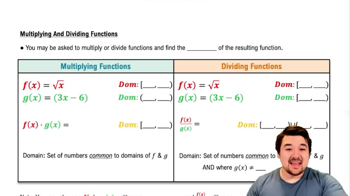If r = sin(f(t)), f(0) = π/3, and f'(0) = 4, then what is dr/dt at t = 0?
Table of contents
- 0. Functions7h 54m
- Introduction to Functions16m
- Piecewise Functions10m
- Properties of Functions9m
- Common Functions1h 8m
- Transformations5m
- Combining Functions27m
- Exponent rules32m
- Exponential Functions28m
- Logarithmic Functions24m
- Properties of Logarithms36m
- Exponential & Logarithmic Equations35m
- Introduction to Trigonometric Functions38m
- Graphs of Trigonometric Functions44m
- Trigonometric Identities47m
- Inverse Trigonometric Functions48m
- 1. Limits and Continuity2h 2m
- 2. Intro to Derivatives1h 33m
- 3. Techniques of Differentiation3h 18m
- 4. Applications of Derivatives2h 38m
- 5. Graphical Applications of Derivatives6h 2m
- 6. Derivatives of Inverse, Exponential, & Logarithmic Functions2h 37m
- 7. Antiderivatives & Indefinite Integrals1h 26m
- 8. Definite Integrals4h 44m
- 9. Graphical Applications of Integrals2h 27m
- 10. Physics Applications of Integrals 3h 16m
- 11. Integrals of Inverse, Exponential, & Logarithmic Functions2h 31m
- 12. Techniques of Integration7h 41m
- 13. Intro to Differential Equations2h 55m
- 14. Sequences & Series5h 36m
- 15. Power Series2h 19m
- 16. Parametric Equations & Polar Coordinates7h 58m
3. Techniques of Differentiation
The Chain Rule
Problem 3.6.75f
Textbook Question
Suppose that functions f and g and their derivatives with respect to x have the following values at x = 2 and x = 3.

Find the derivatives with respect to x of the following combinations at the given value of x.
f. √f(x), x = 2
 Verified step by step guidance
Verified step by step guidance1
Step 1: Recall the chain rule for derivatives. If h(x) = √f(x), then h'(x) = (1 / (2√f(x))) * f'(x). This formula is derived by differentiating the square root function and applying the chain rule.
Step 2: Identify the values of f(x) and f'(x) at x = 2 from the table. From the table, f(2) = 8 and f'(2) = 1/3.
Step 3: Substitute f(2) and f'(2) into the derivative formula h'(x) = (1 / (2√f(x))) * f'(x). This gives h'(2) = (1 / (2√8)) * (1/3).
Step 4: Simplify the expression. The square root of 8 can be written as √8 = 2√2. Substitute this into the formula to simplify further.
Step 5: Combine the constants and simplify the fraction to express the derivative in its simplest form. Do not calculate the final numerical value, as the focus is on the process.
 Verified video answer for a similar problem:
Verified video answer for a similar problem:This video solution was recommended by our tutors as helpful for the problem above
Video duration:
4mPlay a video:
Was this helpful?
Key Concepts
Here are the essential concepts you must grasp in order to answer the question correctly.
Derivative
The derivative of a function measures how the function's output value changes as its input value changes. It is defined as the limit of the average rate of change of the function over an interval as the interval approaches zero. In this context, knowing the derivatives of functions f and g at specific points is crucial for finding the derivatives of their combinations.
Recommended video:

Derivatives
Chain Rule
The chain rule is a fundamental theorem in calculus used to differentiate composite functions. It states that if a function y is composed of two functions u and v, then the derivative of y with respect to x can be found by multiplying the derivative of y with respect to u by the derivative of u with respect to x. This rule is essential for differentiating functions like √f(x), where f(x) is itself a function.
Recommended video:

Intro to the Chain Rule
Square Root Function
The square root function, denoted as √f(x), is a function that returns the non-negative square root of f(x). When differentiating this function, it is important to apply the chain rule, as the derivative of √u (where u = f(x)) involves the derivative of f(x) as well. Understanding how to differentiate square root functions is key to solving the given problem.
Recommended video:

Multiplying & Dividing Functions

 5:02m
5:02mWatch next
Master Intro to the Chain Rule with a bite sized video explanation from Patrick
Start learningRelated Videos
Related Practice
Textbook Question
